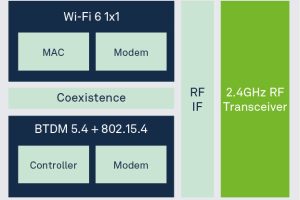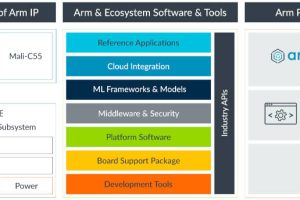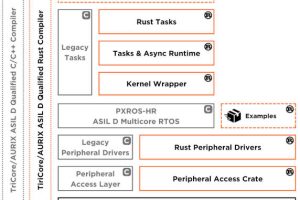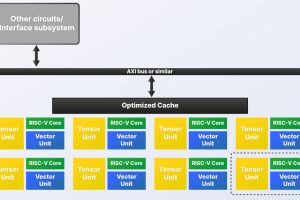
For the first installment of this Industry Insiders Interview Series, I spoke with Jack Browne, Senior Vice President of Marketing at Sonics, Inc. I have the pleasure of working with Jack on a regular basis, as Sonics is a member of IPextreme’s Constellations program, a collective of like-minded IP companies collaborating to better serve our customers.
Warren: Thanks for meeting with me today, Jack. It’s always a pleasure. To begin, can you share a little background on yourself and how you got into the IP business?
Jack: I have been in the semiconductor business for more than thirty years and have always focused on providing system-level solutions. My experience has split into three areas: microprocessor chips, SoC’s, and IP (processor IP, then system IP) for SoC’s. In marketing and sales, I have had the enjoyable experience of helping many innovative teams solve some of the most challenging problems of our time.
WS: So, how would you rate the experience of working in IP versus other jobs you’ve held?
JB: As you work with the leaders in the industry to solve problems, collaborating with customers to give them a differentiated competitive advantage is exciting. It is amazing to see how much differentiation can be enabled as companies work to build platforms that scale over time. Helping customers scale software platforms to various price points while mixing and matching IP is the big benefit of applying System IP, such as that provided by Sonics.
WS: There has been tremendous consolidation of the IP market in recent years, with a number of the small and medium players getting gobbled up by the big guys. What does this tell us?
JB: With the increasing number of IP cores in SoC’s, companies are working to manage supply chain complexity, as well as increase design productivity. “One stop shopping” strategies encourage acquisition of popular IP cores by leading IP suppliers, but with lots of customers, differentiation is harder than integrating best-in-class IP from a broader range of suppliers. Customers want the right differentiation while simplifying the supply chain.
Making sure the SoC designer is aware of high-value IP requires demonstrating interoperability and proving value with known IP solutions, and it helps an IP company reach a broader customer base. “Interoperate or die” is the alternative to “be acquired or die.” Clearly showing value is more important than ever. Having Sonics System IP that enables other IP to work eases the difficulty of integration and interoperability when compared to alternatives.
WS: The tech media of today, at least in the US, seems to have drastically shrunk. Famous editors are now working for product companies. How do you get your message out to customers in such an environment?
JB: In today’s fast moving flat world, the Internet provides indexed access to orders of magnitude more information than before. Reaching engineers and technical decision-makers today means not only leveraging the remaining technical media, but also promoting solutions effectively to users in their context.
For IP companies, the most effective results come from sharing solutions that target the most interesting vertical markets with material benefit for the SoC design. For Sonics, providing the System IP functions and performance tooling means the SoC architect defines the desired user experience for an SoC with dozen’s of IP cores; while the back-end Place & Route activities implement the architect’s vision exactly. Having a common view of the planned architecture that matches the implemented architecture means that software development can be parallelized to shorten the overall time to market.
Succinctly and efficiently sharing solutions to end user problems is more challenging with fewer editors helping to explain technologies and share best practices in using new technology. Customer understanding is more dependent on better marketing from the vendor that crisply defines why a solution should be considered.
WS: What’s the biggest change you’ve seen in the market since the meltdown of late 2008?
JB: The ever increasing complexity of winning SoC’s is the big change in the market – Apple’s first iPhone captured the imagination of what could be, and today Apple is a benchmark for a winning user experience. The scope of the effort required to be successful in designing SoC’s continues to scale. With the continued shrinking of transistor geometries, today’s most advanced SoC’s may have 200 or more IP cores to be integrated, and with 3D packaging, the system encompasses more than just the SoC. Even microcontrollers (MCU’s) have increasing complexity, integrating 50+ IP cores for various functions that may include: location data, video, and voice to support better user interactions with devices.
WS: It wasn’t long ago that many IP companies were worried about licensing IP to China. Has that changed post-2008?
JB: Today, Chinese companies have become top global suppliers: Huawei, Lenova, and ZTE, to name a few, with others to follow. As such, Chinese companies need to protect their own IP so that they will continue to grow. As an IP company, we want our customers to protect our IP as they would their own IP. Both the IP vendor and the Chinese customers seem to have a common view of protecting IP today.
WS: Let’s bring out our crystal ball for a moment. What do you predict will be the biggest, most disruptive change in semiconductors in the next 3 years?
JB: The effects of the cloud will be the most disruptive as we continue the move from standalone devices to devices that capture our interactions with the world according to our own unique view. Cloud connectivity enables content and convenience. With more parallelism in the SoC as well as the Cloud, user experience benefits from functionality in both. Consider, for example, the improved user experience as the browser function is split between the SoC and the cloud for Amazon’s Kindle Fire.
As billions of mobile devices connect to tens of billions of “Internet of Things” devices, we will see amazing solutions with far better user interfaces for organizing and simplifying our lives. Automation of lights, security, and other devices in the home are today’s examples, though most complain of the complexity to manage our surroundings with today’s capabilities.
WS: It seems like there just aren’t any hot new startups anymore, while even industry titans are merging, as we saw with Texas Instruments’ recent acquisition of National Semiconductor. Are you apprehensive about such consolidations in the semiconductor industry?
JB: While the pace of new semiconductor startups has slowed, there is still a lot of innovation as competitive pressures push time-to-market and better user experience. Acquisitions continue as companies work to refresh capabilities and to acquire skills and mass, which are necessary for competitive success in key markets. Acquisitions provide an exit for private companies as the cost of SoC design rises.
WS: What would be your recommendations for new EE grads coming into the semiconductor world today?
JB: Embrace challenges. If you like doing the same thing every day, it will be hard to build a career as an EE through your work life; but if you are one of the people who envisions re-imaging things as they ought to be, then you will not be bored as you work to change the world.
WS: Before we go: three words that you would use to describe the semiconductor industry today.
JB: Aggressive, challenging, and exciting.
About Jack Browne, Senior Vice President of Marketing, Sonics, Inc.
Jack Browne is Sonics‘ Senior Vice President of Marketing. Prior to joining Sonics, Mr. Browne served in several executive roles at MIPS Technologies, including Executive Vice President of Worldwide Sales and Executive Vice President of Marketing. Earlier in his career, he was the head of Motorola’s 68000 processor marketing team. An acknowledged industry spokesman, Mr. Browne has written more than 100 papers for industry publications and presented at more than 100 industry conferences. He holds a B.S.E.E. degree from the University of Texas.
Warren Savage, President and CEO of IPextreme, is a well-known and published authority in the field of semiconductor intellectual property.
 Electronics Weekly Electronics Design & Components Tech News
Electronics Weekly Electronics Design & Components Tech News



